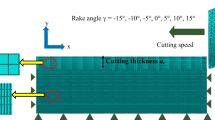Abstract
Theoretical prediction of adiabatic shear band spacing is beneficial to understand the mechanism of the serrated chip formation. The momentum equation, energy equation and compatibility equation in orthogonal cutting are established in this paper. Using perturbation analysis by regarding cutting speed and uncut chip thickness as basic disturbance, an analytical solution of adiabatic shear band spacing is developed. Adiabatic shear band spacing of serrated chip is related to the wave number of the perturbation when the growth rate reaches to maximum. It is found that adiabatic shear band spacing decreases with the increase of cutting speed but increases with uncut chip thickness. The experiment of orthogonal cutting Ti6Al4V under different cutting speeds (50 m/min-1800 m/min) and uncut chip thicknesses (0.02 mm-0.16 mm) verifies the validity of the theoretical prediction.
Similar content being viewed by others
References
Gente A, Hoffmeister HW (2001) Chip formation in machining Ti6Al4V at extremely high cutting speeds. CIRP Ann Manuf Technol 50(1):49–52
Batra RC, Kim CH (1992) Analysis of shear banding in twelve materials. Int J Plast 8(4):425–452
Wright TW, Ockendon H (1996) A scaling law for the effect of inertia on the formation of adiabatic shear bands. Int J Plast 12(7):927–934
Batra RC, Chen L (2001) Effect of viscoplastic relations on the instability strain, shear band initiation strain, the strain corresponding to the minimum shear band spacing, and the band width in a thermoviscoplastic material. Int J Plast 17(1):1465–1489
Molinari A (1997) Collective behavior and spacing of adiabatic shear bands. J Mech Phys Solids 45(9):1551–1575
Yang Y, Wang BF, Hu B, Hu K, Li ZG (2005) The collective behavior and spacing of adiabatic shear bands in the explosive cladding plate interface. Mater Sci Eng A 398(1–2):291–296
Batra RC, Wei ZG (2006) Shear band spacing in thermoviscoplastic materials. Int J Impact Eng 32(6):947–967
Yang Q, Liu Z, Wang B (2012) Characterization of chip formation during machining 1045 steel. Int J Adv Manuf Technol 63(9–12):881–886
Bai YL (1982) Thermo-plastic instability in simple shear. J Mech Phys Solids 30(4):195–207
Batra RC, Chen L (1999) Shear band spacing in gradient-dependent thermoviscoplastic materials. Comput Mech 23(1):8–19
Daridon L, Oussouaddi O, Ahzi S (2004) Influence of the material constitutive models on the adiabatic shear band spacing: MTS, power law and Johnson-Cook models. Int J Solids Struct 41(11–12):3109–3124
Tay AO, Stevenson MG, de Vahl DG, Oxley PLB (1976) A numerical method for calculating temperature distributions in machining, from force and shear angle measurements. Int J Mach Tool Des Res 16(4):335–349
Chen L, Batra RC (1999) Effect of material parameters on shear band spacing in work-hardening gradient dependent thermoviscoplastic materials. Int J Plast 15(5):551–574
Batra RC, Wei ZG (2007) Instability strain and shear band spacing in simple tensile/compressive deformations of thermoviscoplastic materials. Int J Impact Eng 34(3):448–463
Kong F, Chen Y, Zhang D (2011) Interfacial microstructure and shear strength of Ti-6Al-4V/TiAl laminate composite sheet fabricated by hot packed rolling. Mater Des 32(6):3167–3172
Mahboubi Soufiani A, Enayati MH, Karimzadeh F (2010) Mechanical alloying behavior of Ti6Al4V residual scraps with addition of Al2O3 to produce nanostructure powder. Mater Des 31(8):3954–3959
Clifton RJ, Duffy J, Hartley KA, Shawki TG (1984) On critical conditions for shear band formation at high strain rates. Scr Mater 18(5):443–448
Merchant ME (1945) Mechanics of the metal cutting process. I. Orthogonal cutting and a type 2 chip. J Appl Phys 16(5):267–275
Lee EH, Shaffer BW (1951) The theory of plasticity applied to a problem of machining. J Appl Mech-T ASME 18(4):405–413
Oxley PLB, Welsh MJM (1963) Calculating the shear angle in orthogonal metal cutting from fundamental stress, strain, strain-rate properties of the work material. In: Proceedings 4th International Machine Tool Design and Research Conference. Oxford, pp 73–86
Author information
Authors and Affiliations
Corresponding author
Rights and permissions
About this article
Cite this article
Yang, Q., Liu, Z., Shi, Z. et al. Analytical modeling of adiabatic shear band spacing for serrated chip in high-speed machining. Int J Adv Manuf Technol 71, 1901–1908 (2014). https://doi.org/10.1007/s00170-014-5633-x
Received:
Accepted:
Published:
Issue Date:
DOI: https://doi.org/10.1007/s00170-014-5633-x



